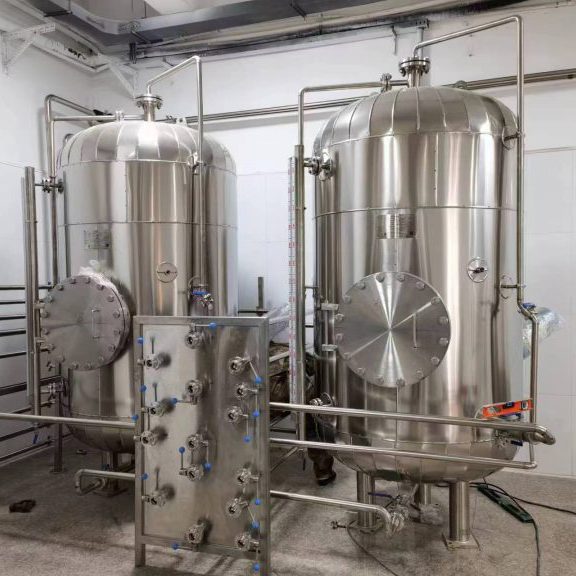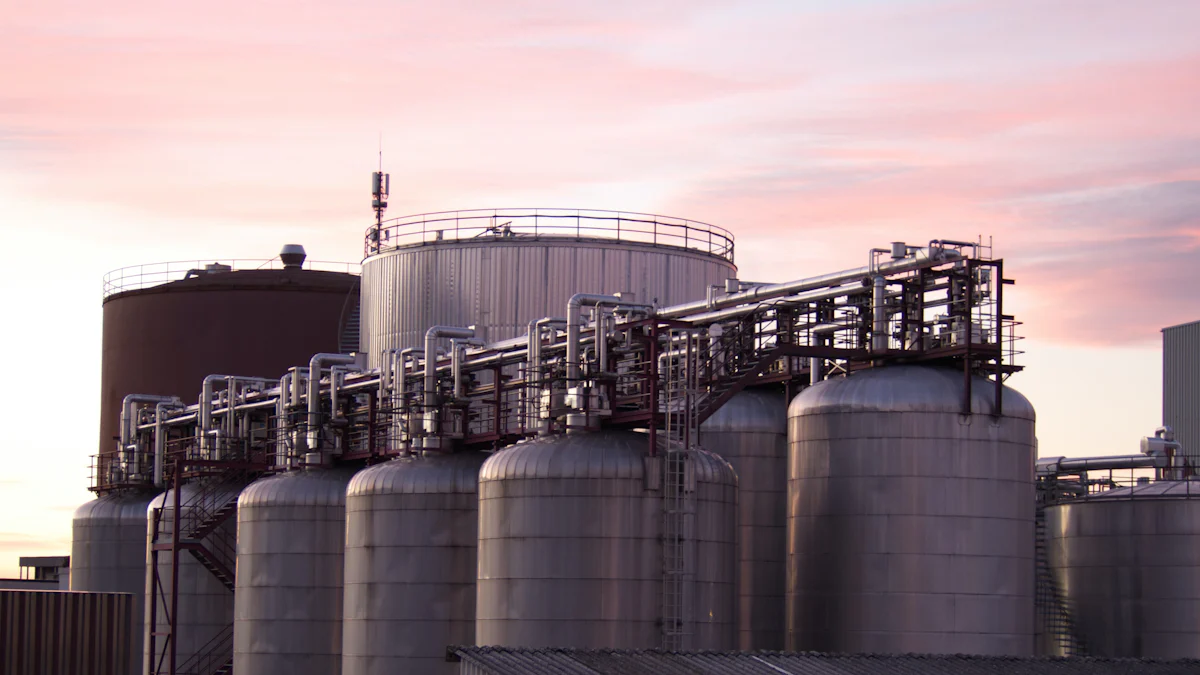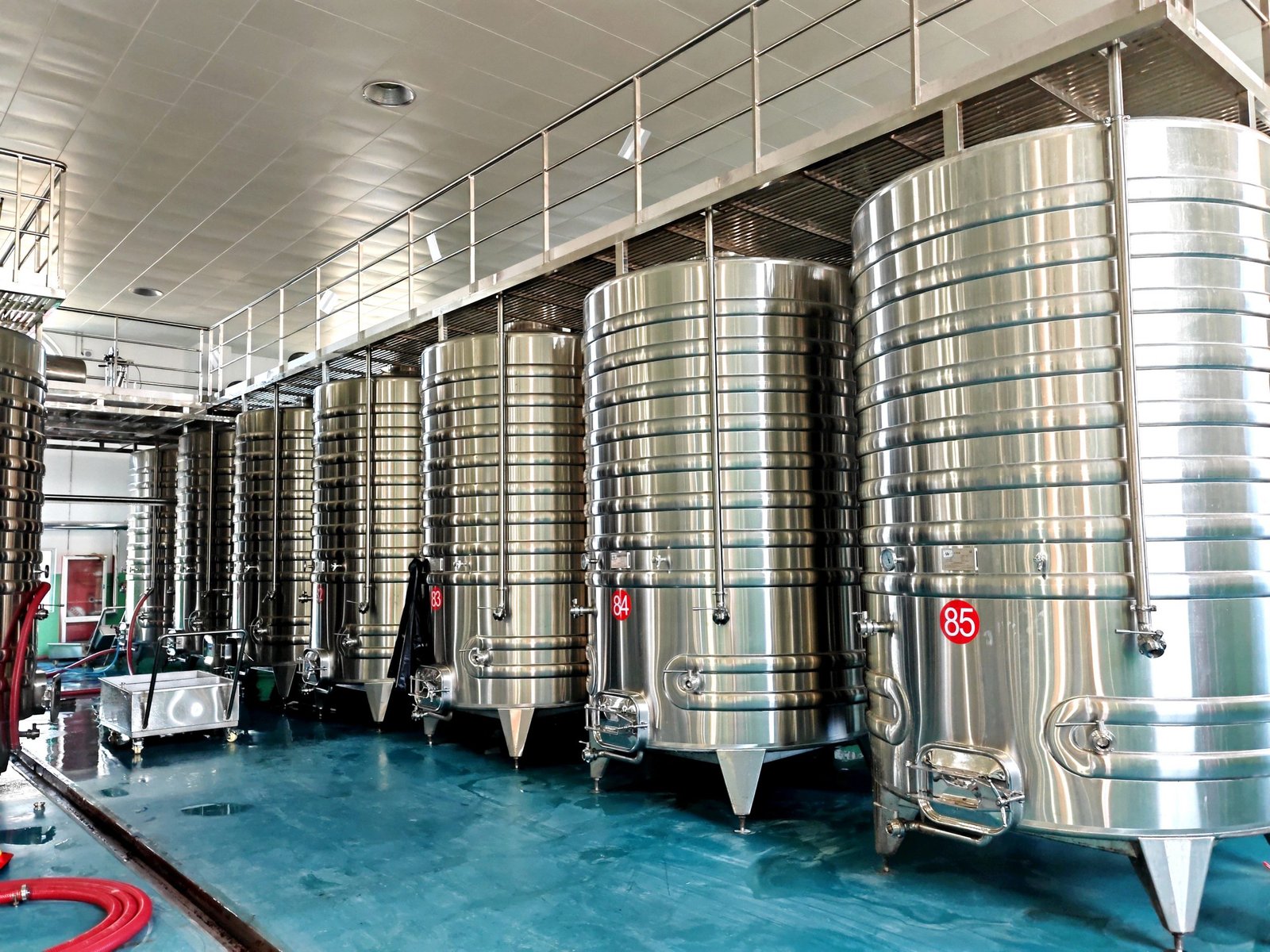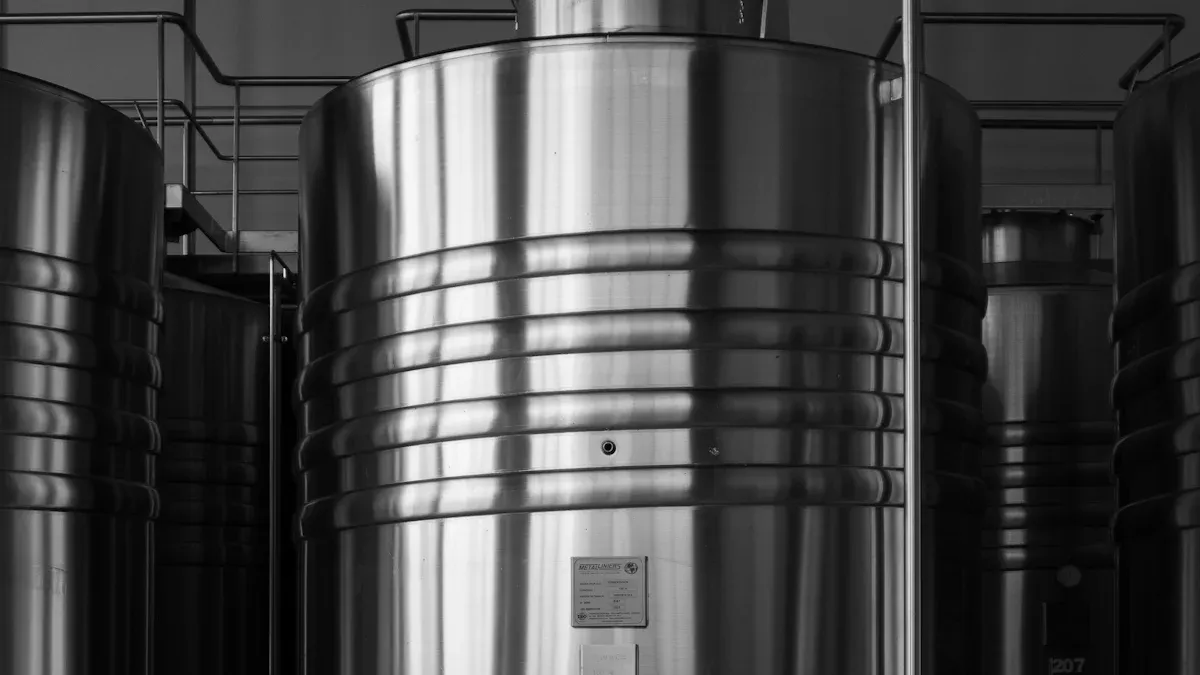
Understanding wine fermentation tank price and features matters more than ever in 2025. Imagine you need to choose between several wine fermentation tank types, each with different costs and key features. The global market for these tanks will reach USD 1.6 billion in 2025, with steady growth ahead. You must balance cost, durability, and long-term value. Top wine fermentation tank manufacturers like Chenma stand out by offering custom stainless steel solutions and advanced technical support.
| Metric/Segment | Value/Projection |
|---|---|
| Market size in 2025 | USD 1.6 billion |
| Projected market size in 2035 | USD 2.4 billion |
| CAGR (2025-2035) | 4.0% |
| Tank and fermenters market share | 35.0% |
Wine Fermentation Tank Price Overview
Price Ranges by Material
When you look at wine fermentation tank price, you will notice that the material makes a big difference. Each type of tank has its own price range, size options, and features. The table below shows common tank parameters and price ranges for 2025:
| Material Type | Capacity Range | Average Price Range (2025) |
|---|---|---|
| Stainless Steel Tanks | 100L – 50,000L+ | $1,000 – $30,000+ |
| Oak Barrels | 225L – 600L | $300 – $1,200 per barrel |
| Concrete Tanks | 600L – 2,000L+ | $2,000 – $10,000+ |
| Plastic Tanks (HDPE) | 20L – 1,000L | $50 – $500 |
You can see that stainless steel tanks have the widest price range. This is because they come in many sizes and can include advanced features. Oak barrels are usually used for aging and have a lower capacity. Concrete tanks are popular in boutique wineries and offer a mid-range price. Plastic tanks are the most affordable, but they have a shorter lifespan.
If you want to compare common tank parameters and price ranges, remember that small-scale fermenters (steel or plastic) cost between $100 and $500. These work well for homebrew or hobby use. Mid-range commercial stainless steel fermenters cost from $1,000 to $5,000. These often include features like temperature control and sediment removal. Large industrial stainless steel fermenters can cost $10,000 or more, especially if they have advanced systems for cooling and automation.
Tip: Stainless steel is the most popular choice for wineries that need durability, easy cleaning, and precise temperature control. Oak, concrete, and plastic each have their own benefits and price points.
Key Pricing Factors
Several factors affect wine fermentation tank price. You should know what drives the cost before you make a decision. Here are the main things to consider:
- Type and Capacity: Larger tanks use more material and take more time to build, so they cost more.
- Material: Stainless steel costs more than plastic or oak because it resists corrosion and is easy to clean.
- Design Features: Tanks with temperature control, stirring systems, or online monitoring have higher prices.
- Brand and Manufacturer: Well-known brands may charge more, but they often offer better quality and service.
- Shipping and Installation: Large tanks are heavy and bulky, so shipping fees and crating charges can add up. For example, you might pay an extra $50 for special packaging.
- Maintenance and Replacement: Some tanks need more upkeep. Stainless steel tanks are easy to clean and last longer, which can save you money over time.
- Market Demand: Prices can change if more people want to buy tanks or if materials become harder to find.
Choosing the right wine fermentation tank affects not just the initial price but also the long-term cost. Tanks with better design and certifications may cost more at first, but they save you money later by reducing cleaning time and lowering the risk of spoilage. Stainless steel tanks, for example, have a higher upfront price but offer durability and easy maintenance. Oak barrels need more care, which increases long-term expenses. Concrete tanks have their own maintenance needs. The material you choose also affects energy costs, especially if you need good insulation or temperature control.
When you compare wine fermentation tank price, always look at the total cost of ownership. This includes shipping, installation, maintenance, and possible upgrades. Investing in high-quality tanks from certified suppliers can help you save money in the long run by reducing spoilage and cleaning labor.
Wine Fermentation Tank Types
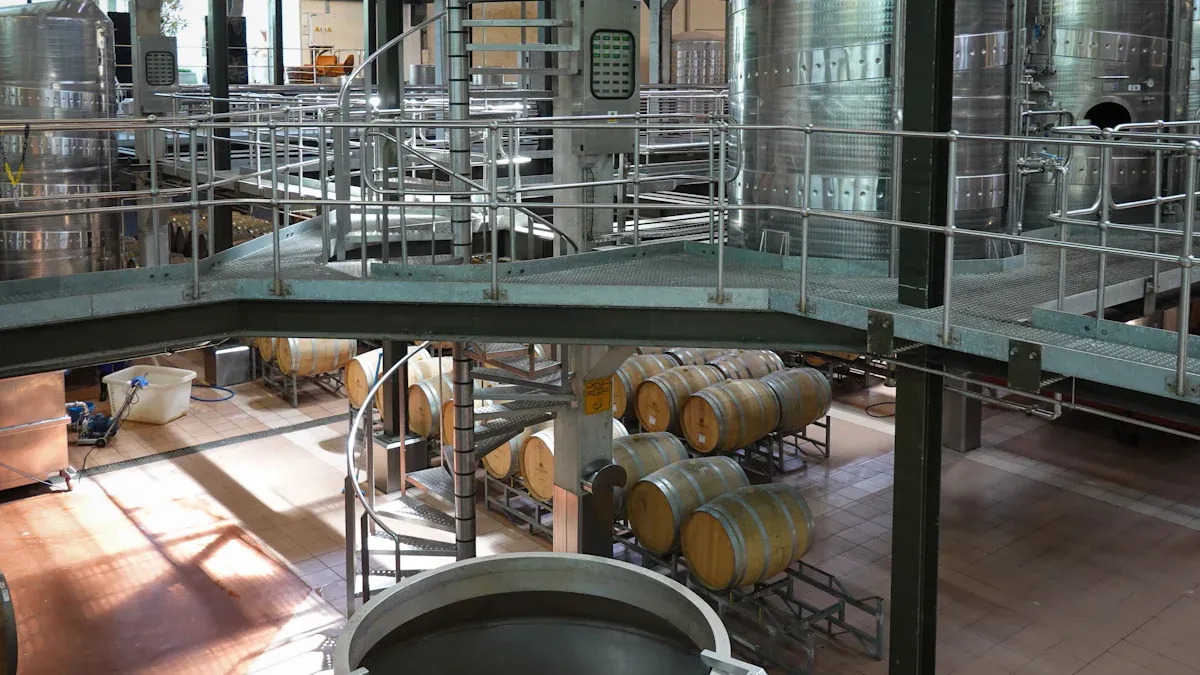
When you explore the types of wine fermentation tanks, you find many options. Each type has unique features, costs, and benefits. Choosing the right tank helps you control the flavor, quality, and style of your wine.
Stainless Steel Wine Fermentation Tanks
Stainless steel wine fermentation tanks are the most popular choice in modern wineries. You get a vessel that is easy to clean, resists corrosion, and keeps your wine safe from unwanted flavors. These tanks allow you to control temperature with built-in cooling jackets. You can use them for all wine styles, including whites, rosés, and fresh reds. Many wineries choose stainless steel vs oak because stainless steel offers better hygiene and repeatable results. You also benefit from a long lifespan, often 20 to 30 years. Stainless steel tanks work well for both large commercial wineries and small boutique producers.
Stainless steel vs oak: Stainless steel tanks do not add flavors, so you keep the wine’s natural taste. Oak, on the other hand, adds vanilla and spice notes.
Oak and Red Wine Fermentation Tanks
Oak tanks and barrels play a special role in winemaking. You often see red wine fermentation tanks made from oak because they add flavors like vanilla, spice, and tannins. Oak tanks sit between stainless steel and barrels. They give you some oak character without the need for many barrels. Red wine fermentation tanks made from oak allow slow oxygen exchange, which helps develop complex flavors. These tanks need more care and cleaning, but many winemakers use them for premium reds and aging.
- Oak tanks: Add flavor, allow slow oxygenation, best for red wine fermentation tanks.
- Lifespan: Usually 3 to 5 years for barrels.
Concrete and Plastic Tanks
Concrete and plastic tanks offer different benefits. Concrete tanks give you stable temperatures and gentle micro-oxygenation, similar to oak but with less flavor impact. You can find concrete tanks in egg shapes or other forms. They last a long time but need regular cleaning. Plastic tanks, often made from HDPE, are lightweight and affordable. You might use them for small batches or experiments. They do not add flavors and have a shorter lifespan.
| Tank Type | Cost Range (USD) | Durability | Maintenance | Flavor Impact |
|---|---|---|---|---|
| Concrete | $2,000 – $15,000 | High, long-lasting | Medium, heavy | Minimal |
| Plastic (HDPE) | $50 – $500 | Low, short-lived | Medium, scratches | None |
Amphora and Hybrid Tanks
Amphora tanks use high-quality clay and traditional shapes. You see them in artisanal or historic winemaking. These tanks allow slow fermentation and help preserve the wine’s terroir. Amphora tanks support long aging and do not add flavors. Hybrid tanks combine materials like stainless steel and wood. You can customize these tanks with features such as floating lids, temperature control, and modular designs. Hybrid tanks work well if you want to blend modern and traditional methods.
Tip: When you compare the types of wine fermentation tanks, think about your wine style, budget, and how much maintenance you want to handle.
Features to Compare
When you choose a wine fermentation tank, you need to compare several important features. These features affect how your wine tastes, how easy the tank is to use, and how much you spend over time. Here are the main features to look for in a high-quality stainless wine tank and other common tank types:
| Feature | Stainless Steel | Oak (Wood) | Concrete | Plastic (HDPE) | Amphorae (Clay) |
|---|---|---|---|---|---|
| Durability | High | Medium | Medium | Low | Low |
| Ease of Cleaning | Easy | Difficult | Moderate | Easy | Moderate |
| Temperature Control | Excellent | Moderate | Good | Limited | Moderate |
| Flavor Impact | None | Adds complexity | None | None | Unique |
| Cost | High | High | Medium | Low | High |
Temperature Control
Temperature control during fermentation is one of the most critical features. You need to keep the wine at the right temperature to develop the best flavors and aromas. Stainless steel tanks often have double-layer jackets that let you heat or cool the wine precisely. This technology helps you avoid temperature swings that can spoil the wine. Tanks with advanced temperature control cost more, but they give you better results and save money by reducing waste. If you want consistent, high-quality wine, choose a tank with reliable temperature control.
Tip: Tanks with precise temperature control help you make wine with stable flavors and aromas every time.
Floating Lids and Valves
Floating lids and advanced valve systems help you manage your wine more easily. A floating lid creates an airtight seal, which keeps air away from the wine and reduces the risk of oxidation. This seal helps preserve the wine’s flavor and aroma. You can also adjust the lid to fit different batch sizes, making your production more flexible. Advanced valves, especially those made from stainless steel, let you sample and drain wine quickly and safely. These features save you time and help you keep your wine safe from contamination.
- Floating lids protect wine from air and spoilage.
- Large stainless steel valves make sampling and draining easy.
- Airtight seals improve shelf life and wine quality.
Maintenance and Durability
You want a tank that lasts a long time and is easy to clean. Stainless steel tanks stand out for their durability and low maintenance. Their smooth, non-porous surface makes cleaning simple and fast. You can use rinse, detergent, and sanitizing solutions without worry. Oak barrels and concrete tanks need more care and can be harder to clean. Plastic tanks scratch easily, which can lead to contamination. When you compare tanks, always check how much work it takes to keep them clean and how long they will last.
Note: Choosing a tank with easy cleaning and high durability saves you time and money in the long run.
Stainless Steel Wine Fermentation Tanks
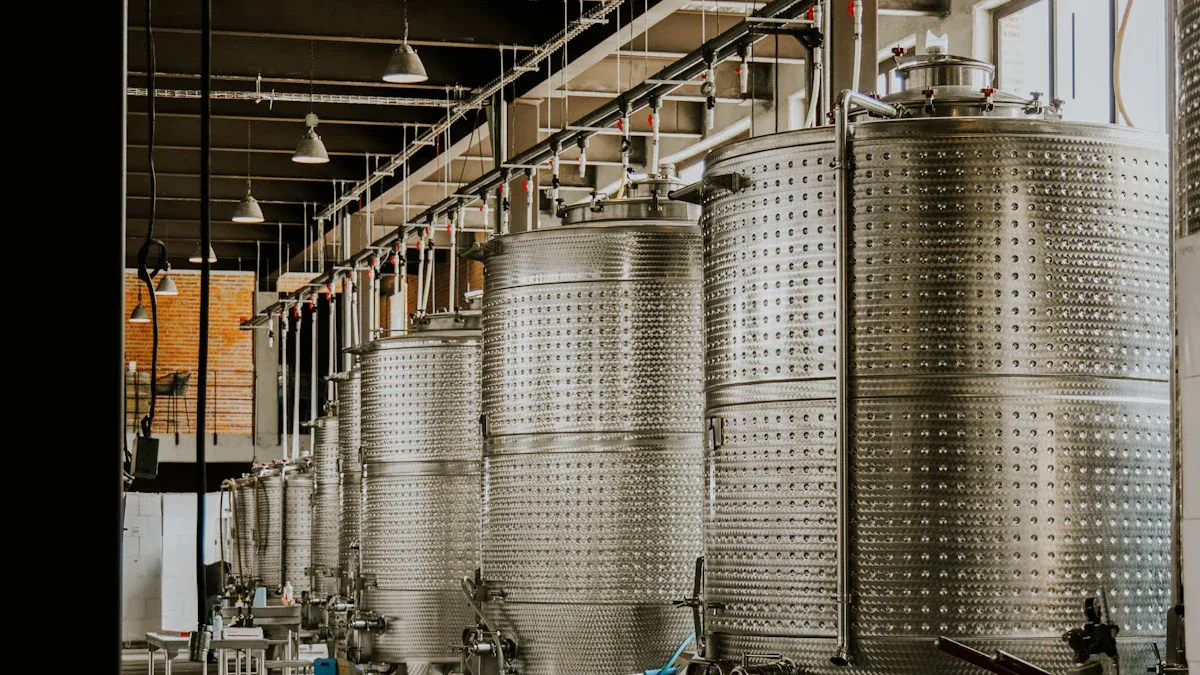
Advantages and Certifications
When you choose stainless steel wine fermentation tanks, you get many important benefits. These tanks last for decades and are easy to clean. They do not rust or react with wine, so your product stays pure. You can trust these tanks to keep your wine safe and fresh.
Top wine fermentation tank manufacturers like Chenma follow strict rules to make sure every tank meets international standards. You should look for these certifications when buying a tank:
- Australia: AS1210 certification
- European Union: PED or TUV certification
- United States and Canada: ASME certification
Manufacturers must provide detailed drawings, weld seam records, and pressure test reports. Each tank comes with all the documents you need for customs and installation. These certifications prove that your tank meets health and safety rules in major wine-producing countries.
Typical Price Range
Stainless steel wine fermentation tanks come in many sizes and price points. You can find small tanks for under $1,000 or large, high-end tanks for over $13,000. The table below shows some common options:
| Tank Model | Price Range (USD) | Description / Notes |
|---|---|---|
| Standard Albrigi Wine Tanks | $7,950 – $13,500 | High-end, polished interior, leading manufacturer |
| Small Variable Capacity Wine Tank | $985 – $1,650 | Compact size, lifting arm optional |
| Small Variable Capacity Wine Tank w/ Arm | $2,075 – $2,275 | Small size with lifting arm |
| Fully Jacketed Open Top Fermenter (6T) | $4,000 | 6 tons, fully jacketed |
| Stainless Steel Cube Tank (1500L) | $3,300 | Cooling jacket, stackable |
| Floating Lid Wine Tanks (800L-5000L) | $3,800 | Multiple sizes, floating lid |
You can see that prices depend on size, features, and brand. Tanks with cooling jackets or floating lids cost more. Larger tanks also have higher prices.
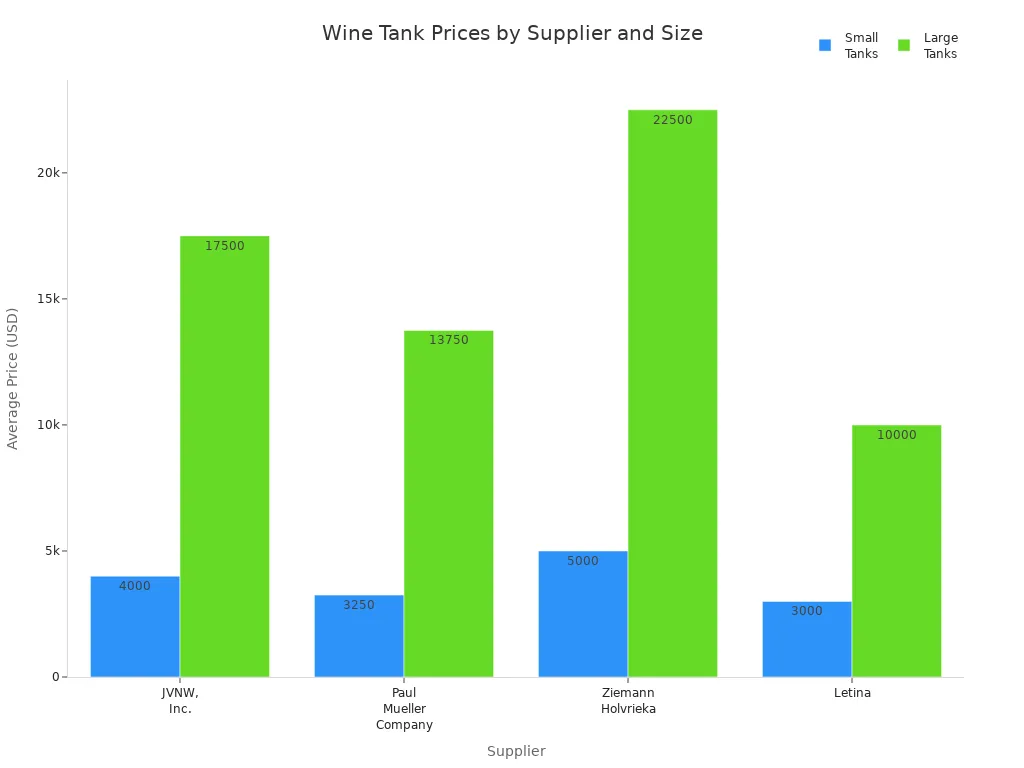
Customization Options
You can customize stainless steel wine fermentation tanks to fit your winery’s needs. Chenma and other top wine fermentation tank manufacturers offer many options. The table below shows some features to look for in a high-quality stainless wine tank:
| Tank Attribute | Details |
|---|---|
| Capacity | Sizes range from 250 liters to over 10,000 liters. |
| Orientation | Choose vertical tanks for space-saving or horizontal tanks for low ceilings. |
| Customization Options | Adjustable lids, cooling/heating jackets, built-in mixers, and sampling ports available. |
Adding features like cooling jackets or mixers increases the price, but you get better control over your wine. You can work with manufacturers to design a tank that matches your production goals. Chenma’s engineers help you select the right options for your winery, ensuring long-term value and compliance with international standards.
Red Wine Fermentation Tanks
Unique Features
Red wine fermentation tanks come in many forms, each with special features that help you make high-quality red wine. You can choose from amphora, hybrid, stainless steel, concrete, or customizable tanks. Each type offers unique benefits for red wine fermentation.
| Tank Type | Unique Features | Benefits for Red Wine Fermentation | Best Use Cases |
|---|---|---|---|
| Amphora Tanks | Natural clay, slow micro-oxygenation, curved shape, natural temperature regulation, high durability | Enhances flavor complexity, softens tannins, preserves flavors | Traditional winemaking, varietals like Sangiovese, Grenache |
| Hybrid Tanks | Stainless steel body with oak staves, precise temperature control, replaceable oak, cooling jackets | Balances fruity and oaky notes, easy cleaning, corrosion resistance | Wines needing subtle oak, wineries moving from barrels to modern |
| Stainless Steel | Integrated cooling/heating, flavor neutrality, corrosion resistance, easy cleaning, variable capacity | Consistent yeast activity, prevents contamination, flexible volume | Small to large scale, many fermentation styles |
| Concrete Tanks | Thermal stability, porous structure, flavor neutral, resists mold and bacteria | Enhances texture, softens tannins, preserves grape character | High-quality reds with enhanced texture and flavor |
| Customizable Tanks | Automated controls, IoT integration, energy efficient, durable materials | Tailored environment, real-time monitoring, improved consistency | Modern winemakers, advanced process control |
You can see that red wine fermentation tanks offer features like micro-oxygenation, temperature control, and easy cleaning. These features help you manage tannins, preserve fruit flavors, and create complex wines. Tanks with advanced controls let you monitor fermentation in real time, which improves consistency and quality.
Tip: Choose a tank that matches your winemaking style and the grape varieties you use. Tanks with micro-oxygenation work well for bold reds, while stainless steel tanks give you flexibility and easy cleaning.
Price Considerations
The price of red wine fermentation tanks depends on the material, size, and features you select. Stainless steel tanks usually cost more upfront, but they last for decades and require little maintenance. Amphora and concrete tanks have higher initial costs due to their craftsmanship and materials. Hybrid tanks with oak staves add value by blending modern and traditional methods, but they also increase the price.
You should also consider the cost of advanced features. Tanks with automated controls, cooling jackets, or IoT integration cost more, but they save you time and reduce manual labor. Larger tanks cost more because they use more material and offer higher capacity. Customizable tanks let you choose only the features you need, which helps you control your budget.
When you compare red wine fermentation tanks, look at the total cost of ownership. This includes purchase price, installation, maintenance, and energy use. Investing in a high-quality tank can improve your wine and save money over time.
Factors to Consider When Choosing a Wine Fermentation Tank
When you select a wine fermentation tank, you need to think about several important points. These factors help you match your equipment to your winemaking goals and business needs. Let’s look at the main factors to consider when choosing a wine fermentation tank.
Production Scale
You should first decide how much wine you want to make each year. Your production scale will guide your choice of tank size and type. If you run a small winery or make wine at home, you might only need a few tanks with a small capacity range. For large commercial wineries, you need bigger tanks that can handle thousands of liters at once. Stainless steel tanks come in many sizes, from 100 liters to over 50,000 liters. This flexibility lets you pick the right tank for your operation. Always plan for future growth so you do not outgrow your equipment too soon.
Wine Style Goals
Your wine style goals shape the features you need in a tank. If you want to make white wines with fresh, fruity flavors, you should use stainless steel or other inert materials. These tanks help preserve aroma and taste. For red wines, you may choose open-top tanks, oak barrels, or ceramic pots. Open-top tanks allow oxygen in and make it easy to manage grape skins during fermentation. Oak barrels add complex aromas and soften tannins. Ceramic pots, like terracotta amphorae, provide gentle micro-oxygenation and enhance both red and white wines. Some winemakers line amphorae with beeswax to control oxygen for white wines. Each tank type supports different wine styles, so match your choice to your goals.
- White wines: Stainless steel, glass carboys, or closed tanks for freshness.
- Red wines: Open-top tanks, oak barrels, or ceramic pots for complexity.
- Amphorae: Enhance minerality and flavor for both reds and whites.
Budget and Investment
Your budget is one of the most important factors to consider when choosing a wine fermentation tank. Tanks come in a wide price range. Stainless steel tanks cost more at first but last for decades and need little maintenance. Oak barrels and ceramic pots have lower capacity and higher care needs, which can increase long-term costs. Plastic tanks are affordable but have a shorter lifespan. Think about the total cost, including shipping, installation, and upkeep. Investing in quality tanks from trusted suppliers can save you money over time by reducing spoilage and cleaning work.
Tip: Always balance your budget with your production needs and wine style goals. A well-chosen tank supports your business for years.
Choosing the Right Tank
Matching Features to Needs
Selecting the right wine fermentation tank for your winery starts with a clear plan. You want to make sure the tank fits your goals, space, and budget. Follow these steps to match tank features to your needs:
- Check your production scale and batch size. Pick a tank that matches how much wine you want to make and what your market needs.
- Decide on the tank material. Stainless steel keeps flavors pure, concrete adds texture, and oak brings complexity.
- Measure your facility space. Make sure the tank fits your layout and leaves room for future growth.
- Balance your budget. Think about the initial price and long-term maintenance. If your budget is tight, consider smaller tanks or financing options.
- Look for features that help you work better. Good drainage, easy cleaning, and options for customization can improve your wine quality.
- Upgrade with temperature control systems, like glycol cooling jackets, to keep fermentation steady.
- Choose a supplier with strong support and good warranties. This helps protect your investment.
- Plan for the future. Pick scalable tank designs so you can add more tanks as your business grows.
Tip: Talk to experienced suppliers like Chenma. They can help you design a wine fermentation tank that fits your unique needs and supports your winemaking goals.
Balancing Cost and Quality
You want to get the best value from your equipment. Balancing cost and quality means looking at both the price and the benefits each tank brings. Stainless steel tanks may cost more at first, but they last a long time and need little maintenance. Oak tanks add special flavors and work well for high-end wines, but they require more care. Concrete tanks offer a middle ground with good insulation and easy upkeep. Clay vessels give natural micro-oxygenation, which is great for small or organic wineries, but they need careful handling.
- Stainless steel tanks: Durable, easy to clean, and precise temperature control.
- Oak tanks: Add flavor and complexity, best for premium wines.
- Concrete tanks: Moderate price, stable temperature, and customizable shapes.
- Clay vessels: Good for small batches and natural wines, but fragile.
Some small wineries join cooperatives to share high-quality equipment. This helps lower the financial burden while keeping standards high. Careful planning and creative solutions let you balance quality and cost, no matter your winery’s size.
Comparison Table: Tank Types and Prices
When you compare wine fermentation tanks, you see big differences in materials, features, and costs. Each tank type offers unique benefits for your winery. The right choice depends on your production size, wine style, and budget. The table below helps you see how each tank stands out.
| Aspect | Stainless Steel Tanks | Concrete Tanks | Wooden Tanks | Polyethylene Tanks | Hybrid Tanks |
|---|---|---|---|---|---|
| Material | SUS304, SUS316L | Concrete | Oak or other wood | Polyethylene | Stainless Steel + Oak |
| Key Features | Cooling jackets, easy cleaning, corrosion resistance, customizable | Micro-oxygenation, enhances texture | Adds flavors, traditional character | Lightweight, affordable, for small batches | Combines stainless steel and wood benefits |
| Winery Scale | Small to large | Medium | Small, specialty | Small, experimental | Boutique, specialized |
| Price | Varies by grade and features | Moderate, less than high-end stainless steel | High, due to wood and craftsmanship | Most affordable | Higher, due to complexity |
| Temperature Control | High efficiency | Limited, passive | None or minimal | None | Depends on steel component |
| Cleaning & Hygiene | Easy, supports CIP | Harder to clean | Difficult, risk of contamination | Easy | Depends on steel parts |
| Bottom Design | Cone bottom common | Varies | Varies | Simple | Varies |
You notice that stainless steel tanks give you the best temperature control and easy cleaning. These tanks fit both small and large wineries. Concrete tanks help you add complexity to your wine, but they do not offer advanced temperature control. Wooden tanks bring classic flavors but need more care and cost more. Polyethylene tanks work well for small or experimental batches because they are affordable and easy to handle. Hybrid tanks let you combine the strengths of stainless steel and wood, but they come at a higher price.
Tip: When you look at wine fermentation tank price, always check which features matter most for your wine style and production needs. The right tank helps you make better wine and manage your costs.
Choosing the right wine fermentation tank means looking at price, features, and long-term value. You should focus on:
- Size and capacity to avoid wine spoilage
- Reliable temperature control for quality fermentation
- Easy cleaning and strong durability for less maintenance
- Cost that fits your budget and future plans
Manufacturers like Chenma help you with expert advice, custom designs, and full support. Their certified tanks and skilled team make sure your investment lasts and matches your winemaking goals.
FAQ
What is the lifespan of a stainless steel wine fermentation tank?
You can expect a stainless steel wine fermentation tank to last 20 to 30 years. Regular cleaning and proper maintenance help extend its life. Stainless steel resists corrosion and damage, making it a long-term investment for your winery.
How do I choose the right tank size for my winery?
Start by calculating your annual wine production. Choose a tank that matches your largest batch size. Many wineries select tanks slightly larger than needed to allow for future growth. Consult with suppliers like Chenma for custom sizing options.
Do stainless steel tanks affect wine flavor?
Stainless steel tanks do not add flavors to your wine. You keep the natural taste and aroma of your grapes. This makes stainless steel ideal for producing crisp, fresh wines where you want to highlight fruit character.
What certifications should I look for in a wine fermentation tank?
Look for certifications like ISO9001, CE, and ASME. These prove that your tank meets international safety and quality standards. Certified tanks ensure safe operation and easier export to global markets.

